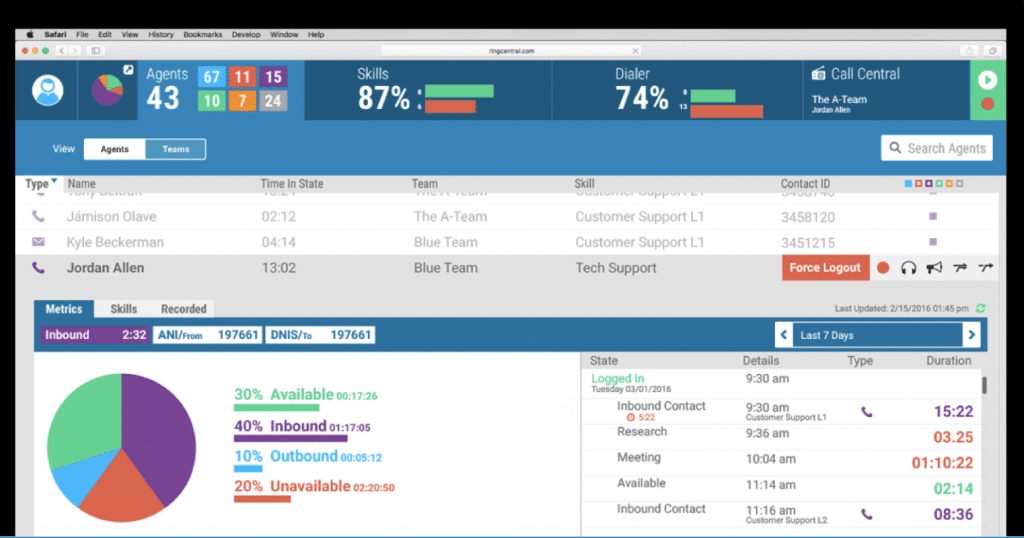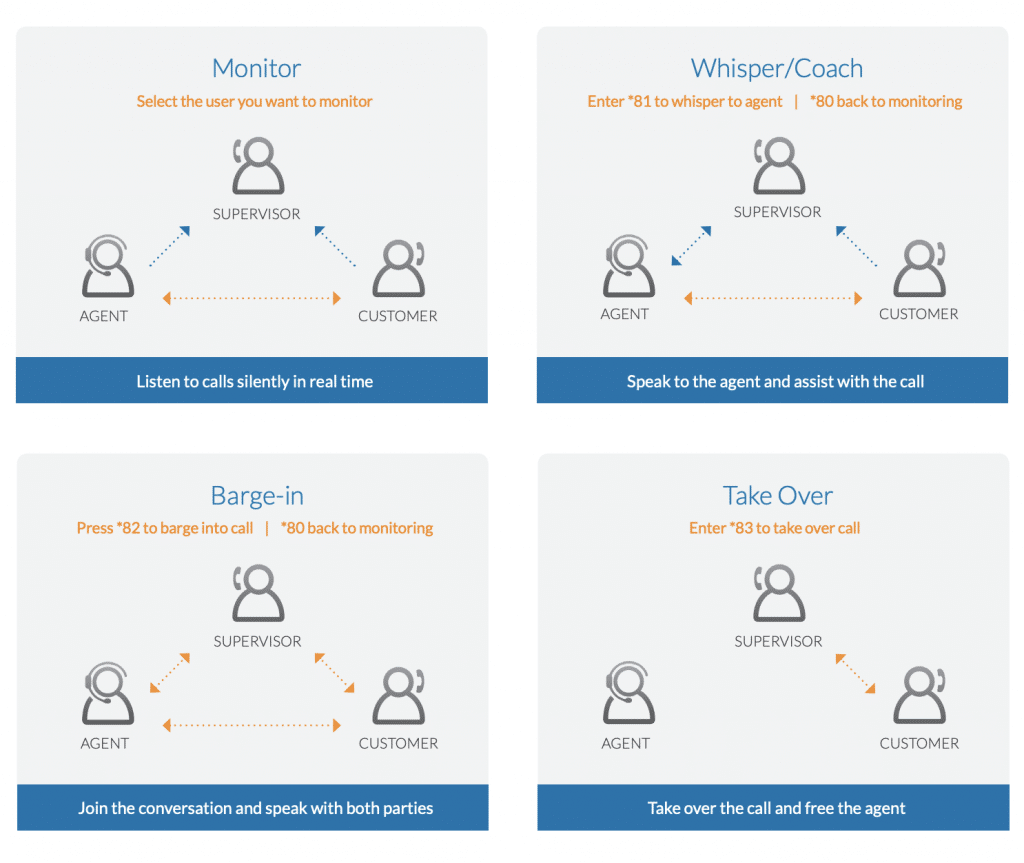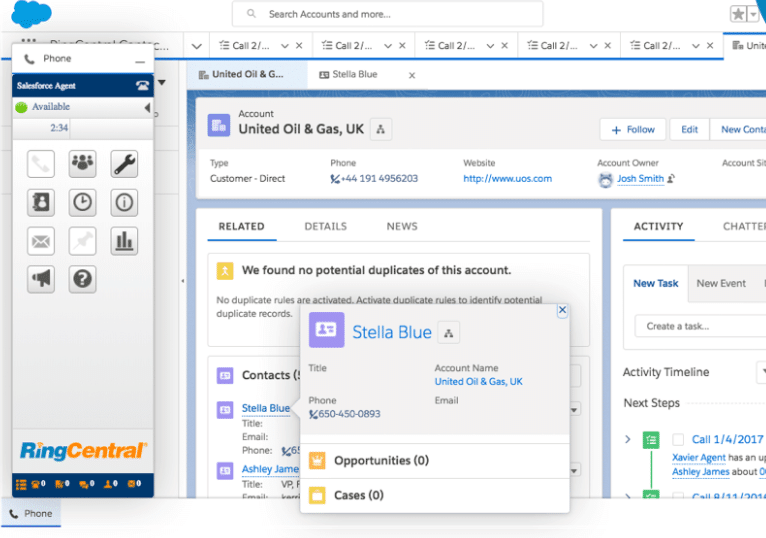As a growing business, you’re probably starting to see the perks of automating some of your more routine processes. Your customer base is on the rise… and so are all the tasks that go along with these new fans. A major bottleneck for a lot of small businesses is customer service, especially when your customer growth outstrips the ability to hire new employees to support them.
This pain can be seen in phones ringing off the hook and people complaining about long hold times or getting the runaround for a simple question. This can lead to some of your more loyal customers walking away; they loved your hands-on service in the beginning, but now you’ve expanded and they feel lost in the shuffle and not as cared for.
That’s where automatic call distributor systems can help.
Today, we’ll cover:
- What is an automatic call distributor system (ACD)?
- What’s the difference between ACD and IVR?
- How does an ACD work?
- 6 benefits of using an ACD as a small business
- 9 features to look for in an automatic call distributor system
Learn about the damage that long hold times can do, and what customers expect from call or contact centers today.
What is an automatic call distributor system (ACD)?
“Your call is very important to us. Please stay on the line.”
If you’ve ever heard that phrase before, congratulations! You’ve interacted with an automatic call distributor system.
An automatic call distributor is software that manages your business’s incoming calls, routing them to the right person or department. Today, this software pulls all kinds of data from your records to better route customers: the number they dialed, existing customer records linked to the phone they’re calling from, and the options they select on your automated menu. An ACD also uses service agent data to make sure the best person possible receives each call. Think of it as a way of offering a strategic element of automated customer service.
This automated system combined with your customer and agent data lets you provide a personalized experience to more customers while resolving their issues more quickly.
What’s the difference between ACD and IVR?
If you read the definition above and thought it sounded a little like interactive voice response (IVR), you’re not alone. IVR is a bit of technology that is often one piece of a full ACD system. If you have an automated menu where customers tell you what services they need, that’s IVR. The larger process of routing the call and connecting the caller with the best possible agent for their need—that’s ACD.
An even simpler example: if ACD were a pizza, IVR would be the cheese—one of the most standard toppings that you’d expect, but not the whole pie.
How does an ACD work?
Now that you have the textbook definition of what an automatic call distribution system is, let’s get down to brass tacks and walk through how ACDs work.
They connect your customers with available agents
When someone calls your business, how should they be directed? ACDs offer a few different methods of routing calls, depending on your business’s needs. It’s a good idea to think about what’s most important to you as you’re setting up your system, so you know which method to choose.
As a handy guide, here are the standard distribution methods you can choose from, along with the pros and cons of each:
1. Fixed routing: Calls come in and are routed to your agents in whatever order you decide, until they reach someone who is available to help them.
The pros: This is a low-maintenance way to use ACD that gets you up and running quickly with the system. All you need is a list of agents in the order you prefer, based on whatever qualifications you choose.
The cons: It’s not a very customized way to go about call distribution, which might impact your ability to get customer concerns handled on first contact. Plus, with all the other features ACD offers, you’re not really getting your money’s worth here.
2. Simultaneous routing: Whenever a call comes in, it’s sent to every phone that isn’t on a call already, and they all ring until someone picks up.
The pros: This option is great if your customers are looking for super-fast response times.
The cons: Quick pickups don’t mean the right person is answering the phone. This could mean customers are put on hold more often, or they’re bounced from desk to desk in search of the right answer.
3. Routing based on average talk time: One of the data-driven methods of ACD, average talk time (ATT) pulls from agent data to see who’s the most open for calls in a given day, based on the number of calls received and amount of time between those calls.
The pros: This might be the right option for you if some members of your service team are more overloaded than others. It can help level-load and make the workday feel more manageable and fair to everyone.
The cons: The most available agent isn’t necessarily the most helpful for any given customer issue. As we’ve said above, this can really cut into your first-call resolution rate and frustrate customers who get bounced around before receiving the help they need.
4. Skills-based routing: Probably the most tailored method of routing. Your ACD uses service agent data like language proficiency and expertise to give each agent a score in different areas of your business. Once callers select their issue, they are assigned to agents who have the most skill in that area.
The pros: This advanced customization means customers are more likely to find the right person, the first time. This can mean better first-call resolution rates and happier, more loyal customers who appreciate the personal touch and trust you to solve their problems quickly.
The cons: Depending on call volume at a given time of day, or the number of agents on the clock who are skilled in a certain area, some customers could experience longer hold times with this routing approach. Try to upskill your agents as much as possible to avoid this from happening.
5. Priority routing: Got big-time customers you want to keep happy? Making them sit on hold can really put a damper on that plan. Priority routing allows you to mark specific customers in your system as VIPs, pushing them to the front of the line for service when they call.
The pros: Happy big spenders who feel special and cared for.
The cons: Potential longer wait times for your non-VIP customers… plus the potential for these customers to find out they’ve gotten the short end of the stick on preferential treatment.
6. Time-based routing: This option can be paired with any of the above. The ACD uses scheduling data to skip over agents who aren’t in the office or are busy when a call comes in.
The pros: Less time spent on hold while the system rings a bunch of agentless or busy phones.
The cons: This is a solid secondary layer to your ACD that will cut down on wait times, but it might result in a little more run-around for customers with specialized questions if no experts are available.
They manage customer queues for you
Does your business have high call volume and need some help keeping folks happy while they wait? It might be time to switch to an ACD, so you don’t have to worry about customers sitting on hold in silence, with no idea when someone will help them.
A good ACD system offers callers the option of staying on the line, with regular updates about their position, or hanging up and getting a call back in the order that they called. Both of these methods are preferable to being stuck on hold at the mercy of the receptionist. (More on automatic call-back later in this blog…)
They handle calls off-hours
Customers today expect 24/7 access to your business, and an ACD can provide a warm and welcoming experience any time of day. You can set a rule on your system to send calls to voicemail during off hours, or even to an emergency phone line.
This is an important benefit if, say, you’re a plumber who needs to know right away when a customer’s pipes burst, or you’re an insurance agent and someone gets rear-ended before your agency opens in the morning. With an ACD in place, your customers only have to remember one phone number to reach you, any time of day.
They monitor calls and agent performance
It’s hard to fairly evaluate your customer service procedures if all you have are the one-sided conversations of your agents. That’s why call monitoring and other call center metrics are so important to delivering delightful customer experiences.
ACDs offer you the ability to listen in on live calls and record them for listening later, if you’d like to monitor call quality more manually, as well as call lengths and volume. More advanced metrics can include voice analytics, which can actually measure customer emotions during a call and create reports based on these emotions across time periods and agents. What a time to be alive, right?
This data all goes into scoring your agents in different areas, so you can evaluate their performance and route calls to them that are in their wheelhouse for better call resolution rates.
They can route more than just your phone calls
Younger generations of customers will do just about anything to avoid calling someone. That’s why the best modern ACD systems also include options for omnichannel routing, so even emails and social media posts get answered by the best possible person for the job.
6 benefits of using an ACD as a small business
1. Connect customers with the right agent, right away
First-call resolution and customer satisfaction are important metrics to track in a call center, because they directly impact your ability to hold onto your customers for the long haul. If you can get your callers to the right agent immediately, they’re more likely to stick around.
This benefit is extra important if you offer customer service in multiple languages. For example, if a Spanish-speaking customer calls, they’re likely to be more comfortable if they can simply press a button and speak to a Spanish-speaking agent the first time, instead of trying to explain their issue first to an agent who might not understand them very well. This can cause confusion as things get lost in translation, which slows down your ability to solve your customer’s issue.
2. Take care of your VIPs
An automated call distributor is so much more than a call-routing service. It also collects data to influence and personalize how each call is routed, which can help you hang onto those most important patrons.
For example, let’s say you have some customers that you want to handle with care: either big-time buyers, or some more difficult folks you’re trying to win over. You can program your ACD to let these “VIPs” skip the call queue, based on their customer data, so they get a live agent quickly every time. This is a great way to personalize your service, which is one way small businesses can compete with the big dogs.
3. Offer every customer a personal touch
No one likes having to repeat their name and problem every time they talk to a new person at your office while trying to find a solution. It makes them feel like a number, not a person. But when your ACD integrates with your customer relationship manager (CRM), all in one place, that means your service team sees a customer’s name and history with your company as soon as they pick up their call.
This personalization can go a long way toward keeping more of your customers coming back… and gushing to their friends about the stellar service you provide.
4. Monitor and support your call center
An ACD collects all kinds of real-time and historical data: call volume on a given day, average call times, customer satisfaction, and even speech and text analytics to monitor agent and customer emotion throughout calls. As you can imagine, all of this information can help you better understand your customers and make decisions to improve your business.

For example, RingCentral Contact Center™ includes supervisor dashboards for monitoring calls and measuring success across your service team.
ACDs also come with coaching tools that allow you to listen in on service calls and assist your agents when they need it, without having to put customers on hold. Plus, you can see who your all-star agents are and who might need some extra training in certain areas. This data will also come in handy when onboarding new agents, as you’ll know the areas that need reinforcing based on your current agents’ knowledge gaps.
5. Expand your team with less overhead
ACDs allow you to bring on customer service agents anywhere in the world while still functioning as one. Whether that means opening a new office in a new city or building a remote support team, you can easily route calls to these other locations. And you won’t need to buy and ship out a bunch of desk phones; ACDs can route to mobile phones, even internationally.
6. Maximize efficiency and get proactive about service
With calls routed to the right agents instead of bouncing around your office, your team can handle more calls more quickly. Depending on how backed up your team is right now, this update could make the difference in how many new agents you need to onboard, which could mean some serious savings.
Using an ACD also might free up your existing team to help out in other ways like proactive, outbound customer surveys and check-ins.
9 features to look for in an automatic call distributor system
1. Cloud-based service for on-the-go access
If you’re going to invest in an automatic call distributor, make sure you find software you can access on your computer and mobile devices, so you’re never out of the loop.
The ideal tool will let you listen to live or past calls, record calls, access metrics, and coach your agents from anywhere.
2. Tools for supervisors
A good ACD can be a supervisor’s best friend, with useful tools that help you measure progress and motivate your team. Whatever software you choose should include the ability to:
- Listen to and record calls
- Manage team schedules to avoid bottlenecks
- Monitor agent attendance and time management
- Assist agents during their calls
- See who’s excelling or struggling, so you can offer praise or help
- Set data-driven team goals
One other fabulous feature to hunt for: “whisper coaching.” Whisper coaching lets you listen in on calls and give advice to your agent without the customer hearing you. This is great for training new agents and also helping on difficult conversations, so the customer spends less time on hold.

RingCentral Contact Center allows you to offer four levels of support to your team while they’re taking calls.
3. Customer routing beyond phones
There are so many ways for customers to contact your business today, and every outreach should be treated equally. The right ACD can help you route contacts from all of these communication channels, not just phone calls, so nothing slips through the cracks.
RingCentral Contact Center’s omnichannel routing allows customers to reach out to you on their most convenient channel and have their questions answered, which can really improve interactions and overall customer satisfaction.
4. Easy-to-use interface
When shopping for an ACD, look for a tool that’s intelligent and intuitive, so you and your team can get up and running with it as quickly as possible.
Your best bet is to find software that puts all customer contact types (phone, email, text, etc.) in one easy-to-navigate screen, to cut down on toggling. For supervisors, there should be a portal dedicated to everything you need: reports, campaigns, agent performance, and more.
5. Skills-based routing
Who are your customer service superstars? A great ACD won’t just send your calls to the right department; they’ll send calls to the best person for the job. If you have an agent who’s crushing the game at troubleshooting, for example, you can program your ACD to send them more of this kind of request to improve first-call resolution on these issues.
Skills-based routing is a feature that can help increase your service center’s efficiency and offer more personalized experiences to your customers. And that means happy customers who can’t wait to buy from you again.
6. Automatic call-back
This is a game-changing trend you’ll want to jump on, as more and more customers expect it today: the ability to hop off the queue and get a call from you when it’s their turn to be served. This gives your customers the ability to go about their lives instead of being held hostage by hold music.
Make sure whatever ACD you choose has the automatic call-back feature. It’s a huge reason Coolhead Tech said RingCentral’s ACD is a real “crowd pleaser.”
🕹️ Get a hands-on look at how RingCentral works by booking a product tour:
7. Integrations
The point of good technology is to make our lives easier, not add more clutter. That’s why we recommend finding an ACD that pairs with your existing tools, so you aren’t constantly opening and closing different windows and apps just to do your job.
With the right integrations connecting your customer service apps and sales software, for instance, when an agent picks up the phone, they already know who the customer is on the line, which helps to give your business a more personalized feel.

If you use a CRM like Salesforce, RingCentral Contact Center integrates smoothly with it, which improves the experience your customers have with an ACD.
With the right ACD, you should be able to monitor calls and provide most other supervisor duties, all in the same place.
8. Powerful analytics
If you’re going to shell out the dough for an ACD, try to get more bang for your buck when it comes to analytics. Most ACDs will offer phone-based metrics: call volume and lengths, resolution time, et cetera. But with so many ways for customers to contact you, why not measure all your customer interactions in one place?
The best ACDs will include ways to monitor success rates and customer emotions during phone calls and text-based conversations in addition to your standard call center metrics.
9. Scalability
If you’re looking into an automatic call distribution system, chances are you’re a company that’s outgrown the systems that helped you get off the ground. A great ACD should alleviate future growing pains, because it can scale up right alongside your business.
When looking for an ACD, be sure to think ahead. Plan for growth, and pick software that is built to last and grow with you.
Is it time for an automatic call distributor system?
If your agents are bogged down by high call volume, and customers need to call you multiple times for one problem, it might be worth investing in an automatic call distributor for your small business. Every customer counts when you’re growing a business, and a little more automation can go a long way to keeping them happy.
You probably already guessed this, but RingCentral Contact Center includes a fully loaded ACD, with all of the essential features you need. There are lots more bells and whistles than we’ve covered here!
We know adding new tech to your business is a big step. Reserve a free demo with a real person, so you can ask questions and learn how RingCentral Contact Center can transform customer care at your business.
Originally published Mar 31, 2020, updated Jan 07, 2024





